This document is a strawman proposal for an abstract model for
XP.
The challenge of crafting a protocol specification is to create a
description of behaviour that is not tied to any particular approach
to implementation. There is a need to abstract away from some the
messy implementation details of buffer management, data representation
and specific APIs. However, in order to describe the behaviour of a
protocol one has to establish a set of (useful) concepts that can be
used in that description. An abstract model is one way to establish a
consistent set of concepts. An abstract model is a tool for the
description of complex behaviour – it is not a template for an
implementation... although it should not stray so far away from
reality that it is impossible to recognise how the required behaviours
would be implemented.
This document is a strawman proposal for an abstract model for
XP. It is by no means complete or polished and at this stage the
authors just like to get some sense as to whether there is an
consensus that such a model is a useful contribution to the XP
effort.
This document is not a W3C Technical Report. It is to be
considered work in progress and does not imply endorsement by the W3C
membership nor by the XML Protocol WG. It is currently under review
and discussion by the XML Protocol WG.
Discussion of this document will take place on the public <xml-dist-app@w3.org> mailing
list (Archives)
as indicated by the email
communiation rules provided in the WG charter.
@@@
1.
Abstract Model for XP
An abstract model is a useful means to develop a
description of a system. It abstracts away from practical details such as
specific API definitions, data representation, and buffer management. It
provides a way to give a precise description of the externally visible behaviour
without being prescriptive of implementation architecture.
2.
Outline (Abstract) Architecture
The diagram below exposes the various processing elements
in an XP system: XP Clients, XP Intermediaries and XP Layer Entities.
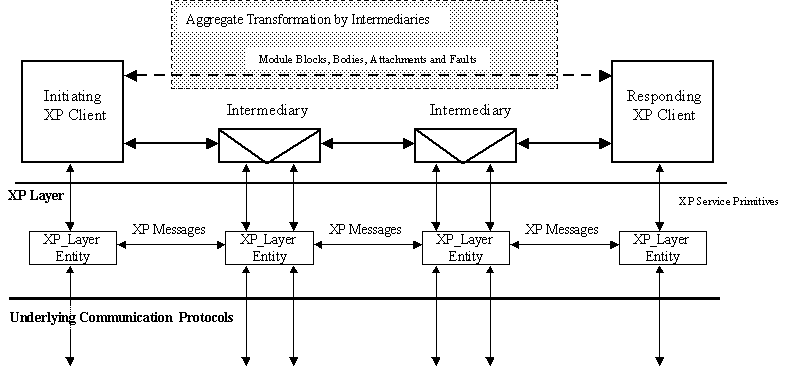
XP clients are clients (users) of the XP layer. The
XP layer provides and abstraction for the transfer of XP messages between XP
clients. XP clients send and receive XP messages through the invocation of XP
layer service primitives
at XP service access points. The exchange of service primitives occurs between
XP (layer) clients and XP layer entities. XP clients are responsible for
application specific processing of XP messages, including XP Module processing.
[With respect to the Axis Architecture [2] an XP client
encapsulates the functionality of input and output chains and dispatcher.]
[At present it is difficult to determine whether XP module
processing should be regarded as something that happens within the XP layer
(which would 'fatten' the role of the XP layer entity) or whether its should
be regarded as ocurring winthin the XP client. This strawman models XP module
processing as occuring within the XP client. So at least for the time being they
are regard as application layer entities which places them within the XP client
(from an abstract POV) rather than within the layer.
The difficulty here is in abstracting some sense of service
and service interface for something that is largely unspecified by XP. It would
be possible to pull module processing within the XP layer IFF it could be regard
solely as filtering chains that operate on inbound and outbound messages between
XP layer entities and XP clients. I believe it would also be possible for such
chains to be stateful in the sense that the processing of a given message may be
dependent on the processing of previous messages. The external (to the
processing chain) interface as seen by both the XP client and the XP layer
entities must be an (abstract) XP message.
There are a great many issues wrt XP module processing:
failure and recovery from a partially processed message; ordering semantics of
module processing – message order, node configuration dependent...; orthogonal
modules and dependencies.]
XP intermediaries are XP clients (see section 5
below) that form a processing chain between an XP client that initiates the
sending of an XP message and the XP client that ultimately receives and
potentially responds to that message.
XP layer entities serialize and deserialise XP
messages. XP messages are composed from (and decomposed into) information passed
in the parameters between the XP layer entities and XP layer clients. XP layer
entities are responsible for enforcing the XP rules of procedure and for the
binding of the XP layer to underlying communications protocols.
[If module processing were pulled inside the XP layer it would
become part of the role of an XP layer entity which would then enforce the
behavioural rules associated with the XP modules it supports]
XP Service Access Point is a conceptual point at
which XP services are accessible. XP is an asymmetric protocol and the address
of the initiating XP client (ie. the 'name' of its service access point) may
be unavailable ie. it may not be explicitly addressible by a remote or
responding XP client.
[In practical terms in XP SAP would likely be implemented as a
programming language object or objects that provided an APIs for sending and
receiving XP messages.
This abstraction is similar to an aggregation of the Transport
Listener, deserialiser, canonicalizer and router and Transport Sender and
serializer from theAxis Architecture [2]]
XP Message is the unit of exchange between peer XP
layer entities. In the abstract it is a structure that represents the contents
of the XP envelope and plus any attachments (whether carried within the envelope
or externally in-line within the binding specific 'message wrapper' eg SOAP
with attachments.
My preference is to regard an XP message as abstract. It
has several concrete representations throughout its lifetime: it has a concrete
representation within the memory of a device implementing XP;and
it has a binding specific serialization whilst being transferred between
XP layer entities. My preference would be that there is a canonical XML
representation for an XP message and that some bindings may 'optimise' this
such that attachments are carried in-line but outside the XP envelope.
2.
Strawman Service Definition for XP
This section focuses on the definition of the abstract
services provided at the XP layer interface. Two services are modelled here, a
unidirectional XML datagram service (XP_UnitData) and a bi-directional XML
request/response service (XP_Data), both are assumed unreliable and capable of
re-ordering and duplicating messages.
- XP_Data
– A bi-directional request/response XP message exchange model by four
service primitive (or events) corresponding to the transmission and
reception of the request and response messages.
- XP_UnitData
– A unidirectional XP datagram service modelled by three service
primitives (or events) corresponding to the start and end of transmission
(from the senders point-of-view) and the reception of an XP message
A response message may arise, however that is a matter for the XP layer
client (and above) through the future invocation of this service or the
XP_Data service in the reverse direction.
Service primitives are abstract events that cross the
boundaries between protocol layers. They are a descriptive device that allow us
to abstract away from practical implementation details such as buffer management
and specific APIs and invocation mechanisms such as upcalls (callbacks),
downcalls, queing and polling mechanisms.
It is important to note that service primitives are an
abstraction. From a descriptive point-of-view they become events and actions
that drive and are driven by the operation of the procedural rules of the
protocol.
.request
Used by initiating clients to start an operation and by intermediaries to
chain an operation toward a responding client. Typically used to start the
sending of a message.
.indication
Used at the responding client and at intermediaties to indicate the
arrival of a message on its 'outward' journey.
.response
In two-way services, used by the responding client and by intermediaries
to return a response or fault toward the initiating client.
.confirm
Used at intermediaries and at the initiating client to indicate the
completion of an operation started by the corresponding .request
primitive.
In the case of a two-way service (XP_Data) it may also carry a response or fault
message on its 'return' journey toward the initiating client.
These four primitives are used in two common interaction
patterns to model the behaviour of two-way request/response operations and one
way datagram operations as illustrated in the diagrams below.
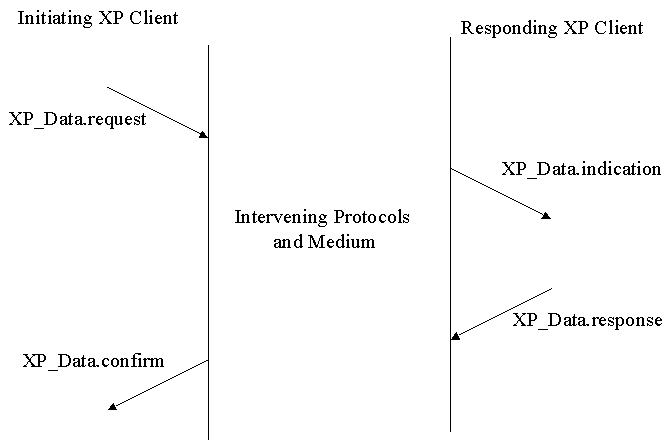
Operation of XP_Data Service: Two-way request/response operation
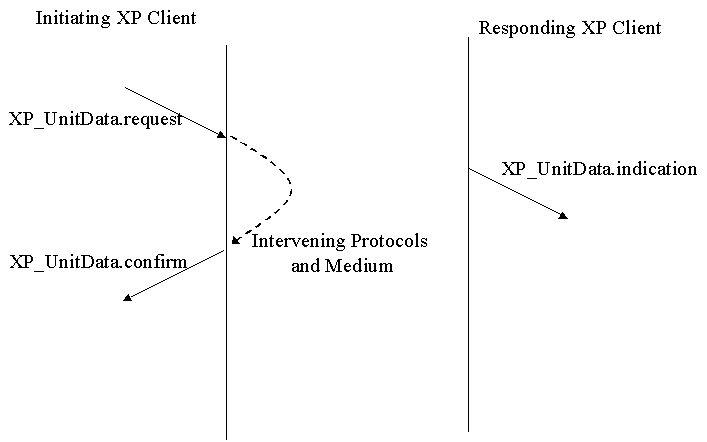
Operation of XP_UnitData Service: One-way datagram operation.
From the initiators point-of-view both of types of
operation start with the invocation of a .request primitive and terminate
with the invocation of a .confirm primitive.
A subtle difference is that in the two-way case the .confirm
primitive arises only after a .indication has been raised at the
responding client, whereas in the one-way case it merely indicates that the
operation is complete from the initiating end's point-of-view. In the one-way
case a (silent) failure may prevent a message from being delivered as an .indication
to the responding client, even though a .confirm is delivered back to the
initiating client.
2.2.
XP_Data Service
The XP_Data service provides an unreliable request/response
service which is modelled by four service primitives. Each primitive models a
transmission or reception event at interface between the XP layer and an XP
client.:
XP_Data.request(
To, [OrigPath], [{ModuleList}], RequestBody, [{AttachmentList}],[BindingContext]);
XP_Data.indication(
To, From, [OrigPath], [ActualPath], [{ModuleList}], RequestBody, [{AttachmentList},
[BindingContext]]);
XP_Data.response(
[{ModuleList}], [ResponseBody|FaultBody], [{AttachmentList}], [BindingContext]]);
XP_Data.confirm(
From, [ActualPath], [{ModuleList}], [ResponseBody|FaultBody], Status, [{AttachmentList}],
[BindingContext]);
All
parameters are detailed in Section 3.4
The service is unreliable since it can fail silently
through the loss of messages in transit. Immediate failures that prevent the
invocation of a primitive are reported as the result of the attempted
invocation.
An XP client may engage in multiple concurrent operations
with the same or different recipients/paths. These concurrent operations are
independent and the order in which they are processed by an intermediary or the
recipient may be different from that in which they are invoked or complete at
the initiator. In applications where sequencing is important an optional XP
module may be used to establish the original ordering within XP layer clients
[Strawman suggestion again].
Failures that arise during message processing at XP
intermediaries or at the intended recipient result in the inclusion of a
FaultBody rather than a ResponseBody in the .response and .confirm
primitives.
This service can be provided over HTTP, HTTPS, SSL/TCP, TCP
and SMTP.
2.3.
XP_UnitData Service
The XP_UnitData service provides an unreliable datagram
service which is modelled by two service primitives that model the transmission
and reception of request message as follows:
XP_UnitData.request(To,
[OrigPath], [{ModuleList}], RequestBody, [{AttachmentList}], [BindingContext]);
XP_UnitData.indication(To,
From, [OrigPath], [ActualPath], [{ModuleList}], RequestBody, [{AttachmentList]},
[BindingContext]);
XP_UnitData.confirm(
[From], Status, [BindingContext]);
All
parameters are detailed in Section 3.4
The service is unreliable since it can fail silently
through the loss of messages in transit.
In general there are no ordering guarantees with respect to
the delivery of messages. Intermediary and recipient processing may re-order
messages. Thus, the order in which concurrent XP_UnitData operations complete is
independent of the order in which they were initiated.
In applications where sequencing is important an optional XP module may
be used to establish the original ordering within XP layer clients.
[The one-way and unreliable nature of the interaction mean
that failures during recipient XP processing should result in a message sent in
a one-way message carrying a FaultBody in the reverse direction. It is also
important that a failure to deliver a fault message does not give rise to
further fault messages]
This service may be implemented over HTTP, HTTPS, SSL/TCP,
TCP, SMTP and UDP.
This section describes the (abstract) parameters that are
used in the service primitives. These parameters are abstract in the sense that
no attempt is made to relate them to any concrete representation of the values
they represent. They would typically relate to the parameters of an API (if the
an API were closely modelled on this service definition), however, they are only
given a narrative description here.
|
To
|
An identifier that denotes the intended XP client
that a message is being sent to. The sense of this parameter follows the
direction of flow. In .indication this parameter denotes the XP
client to which the message was sent in the corresponding .request
primitive. This enables the identity of the originally intended recipient
to be preserved despite possible redirections imposed by underlying
protocols.
.response primitives do not carry a To
parameter because the intended recipient of the response is implicitly the
initiating XP client.
|
|
From
|
An identifier that denotes the sending XP client in .indication
and .confirm primitives.
In .indication primitives this parameter makes
the identity of the initiating XP client available to the XP processor.
[Intermediaries
may obscure this or we may require that they don't... discuss]
In the XP_Data.confirm primitive this
parameter conveys the identity of the responding XP client after any
redirections that may have been imposed by underlying protocols.
[Again possibly obscured by intermediaries...]
In the XP_UnitData.confirm primitive, this
parameter conveys the identity of the XP client to which an XP message was
sent after any redirections imposed by underlying protocols. NB. Further
redirections may occur that cannot be reported.
|
|
OrigPath
|
A list of identifiers that denote, in order, the path
of intermediaries that the originating XP client wishes to process a
message prior to delivery to the intended recipient.
[We may wish to support the concepts of both strict and
loose sourcerouting of XP
messages as well as implicit XP message routing. The full route taken by a
message may be different from that requested and not fully known to either
initiating or responding clients.]
The ordering of intermediaries and the ordering of
module blocks in ModuleList may be semantically significant.
[Depending on actual design it may not be possible to
preserve the value of this parameter from .request through to
.indication.]
|
|
ActualPath
|
A list of identifiers that denote the actual path of
intermediaries used between initiating and recipient XP clients. This may
differ for OrigPath due to redirections imposed by underlying protocols.
[The actual path taken by a message may only be
partially reported and may be entirely inaccesible.]
The ordering of intermediaries and the ordering of
module blocks in ModuleList may be semantically significant.
|
|
ModuleList
|
An optional list of XP module blocks for inclusion in
(.request and .response) and included in (.indication and
.confirm) XP messages.
The ordering of module blocks and the ordering of
intermediaries in OrigPath may be semantically significant.
|
|
RequestBody
ResponseBody
|
This is the classic payload data that is passed
between XP clients through the operation of the protocol.
This data may be processed and extended by XP
intermediary processors which may guided in their processing by the
presence of XP modules in the ModuleList.
|
|
AttachmentList
|
This is a list of attachments that are required to
accompany the message. These attachments are regarded as opaque byte
arrays whose content is preserved between neighbouring XP clients. XP
Intermediaries may process, add or delete attachments.
Where the underlying protocol(s) natively support
attachments these native facilities will be used in accordance with the
appropriate binding specification. Where there is no native support for
attachments in the underlying protocol, an XML friendly character based
transformation will be applied to carry the attachments within the XP
envelope.
From the point-of-view of abstract service definition
the actual mechanism used to transfer attachments is immaterial, however
particular bindings may employ more efficient mechanisms than others.
[NB. This places an obligation on XP protocol binding
specifications to specify how attachments are to be carried.]
|
|
BindingContext
|
This parameter references an abstract structure that
carries information pertinent to the underlying protocol binding(s). For
example it may carry certificates, ids and passwords to be used by an
initiating XP client to authenticate itself and/or to establish a secure
channel. At the responding XP client or intermediary it may carry the
authenticated id of the principal on whose behalf the operations is being
conducted.
If the information present in the BindingContext is
inadequate for the execution of a given service primitive the invocation
of that primitive will fail with a result that indicates why progress was
not possible.
BindingContext is optional and if not supplied the
local default binding will be used. In the case of multiple bindings being
available, inbound BindingContext indicates how an inbound message was
received and outbound BindingContext constrains the choice of binding used
for a given operation.
[NB This concept places another obligation on XP
protocol binding specifications in that they must enumerate what binding
specific information they require in an outbound BindingContext and what
binding specific information they provide in inbound BindingContexts.]
It may be possible to aggregate BindingContext fields
across multiple protocol bindings – eg. The usage of Realm, UserId,
Password, Certificate values may not be restricted to a single protocol
binding, they may be broadly applicable attributes of the principal.]
|
|
FaultBody
|
This carries an alternate response body in the event
of an XP processing failure either at the responding XP client or at an
intermediary along the path. In the event of such a failure a FaultBody is
returned instead of a ResponseBody.
|
|
Status
|
This parmeter is present in .confirm primitives to
indicate whether the operation has completed normally or not. Abnormal
completion arises when the operation of an underlying protocol fails. Eg.
an attempt to establish a secure channel at a lower layer may suffer an
authentication failure. In such circumstances further information about
the failure should be accessible in the BindingContext.
|
[The service primitives and particularly their parameters are
likely to evolve. In an abstract sense with the execption of BindingContext and
Status, the remaining parameters are an abstraction of the message exchanged
between XP clients. With a suitable definition of an XP message abstraction most
of these paramters could be collapsed into fields within that abstraction.
Particular bindings would be free to 'lift' fields (like To) from an
outbound message and re-express them in lower-level headers or indeed leave them
in place and still use them for the formation of lower-layer headers. Likewise
on inbound messages, bindings could syntehsise message fields from lower-layer
headers if they are not present in within the XML payload. An advantage of
expressing attachments as a separate parameter is that their inclusion within
the XML envelope or another wrapper (eg. MIME multipart) is deferred to the
binding...there will be issues related to the formation of a manifest and
internal references (URIs) for and to attachments].
3.
Abstract Model for XP
Message Processing and Extensibility (XP Modules)
Application specific processing of an XP Message occurs
within XP Clients (initiating, responding and intermediary). XP Messages are
delivered to XP clients in .indication and .confirm service
primitives. Client processing of an XP message may then give rise to the either
a response, in the case of an XP_Data.indication, or the generation of
further .request primitives as governed by the application protocol
operating between peer XP clients. Such application protocols are outside the
scope of the XP activity.
In the case of intermediary XP clients, the response
returned toward the initiator may be dependent on the outcome of processing at
subsequent intermediaries and at the responding client.
The diagram below illustrates the components of an XP
client within this abstract model:
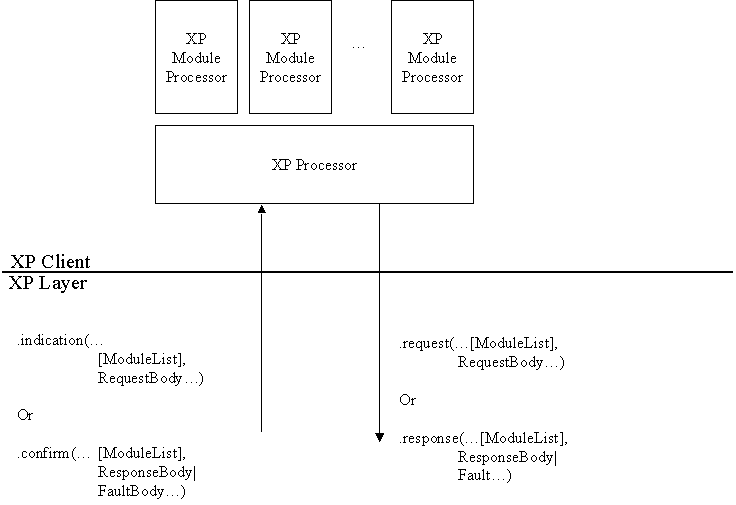
Abstract Model of XP Message Processing
The XP Processor is the principle application
component of an XP client. It is responsible for the application specific
processing of XP messages in accordance with the intended application semantics
of the message body, attachments and any optionally included module blocks. The
processing of XP module blocks in accordance with the rules of procedure
associated with a particular XP module is handed off to a module specific XP
Module Processors.
The model of the interface between XP Module processors and
an XP Processor is deliberately vague. From an XP module specifcation
point-of-view, the important thing to specify with respect to an XP module are:
·
the syntax and semantics of the associated XP module blocks
·
the rules of procedure with respect to the generation of XP module
blocks either in response to the receipt of an XP module block in an inbound
message or at an initiating XP client.
[We will need to decide whether the order of module processing
is semantically significant. We should have an architectural rule about this. It
is probably easier and safer to assert that module processing order is
semantically significant and that it is determined by the order in which module
blocks arise in XP messages. XP clients initiating the transfer of an XP message
may exert an influence of the module processing order by: targetting module
blocks at specific intermediaries; by controlling the ordering of module blocks
within the message]
An XP Processing intermediary is an XP client that
processes XP messages and forwards them on to further intermediaries or the
responding XP client. It may be the message path through intermediaries is
allowed to fork (cf. SMTP). In the case of two-way operation it is then the
responsibility of the intermediary that introduced the fork to coordinate the
formation of the response that is returned toward the initiating XP client.
The processing behaviour of an XP processing intermediary
is similar to that of an ordinary XP client. Inbound messages (.indication
or .confirm primitives) are subject to XP Processing and XP Module
Processing. Depending on the function of the intermediary suitably modified XP
message body, modulelist and path parameters are formed and a revised message
sent on the next leg of its journey. For the two way XP_DATA service, there are
two possible interaction patterns plus hybrid derivatives.
·
Fully Interlocked: The .request propagates fully through to
the responding client which generates a response that propagates fully back to
the initiating client
·
Hop-by-Hop: where each intermediary responds locally and
immediately to its neighbour. Note that with this pattern the response received
by the initiating client does not originate from the responding client.
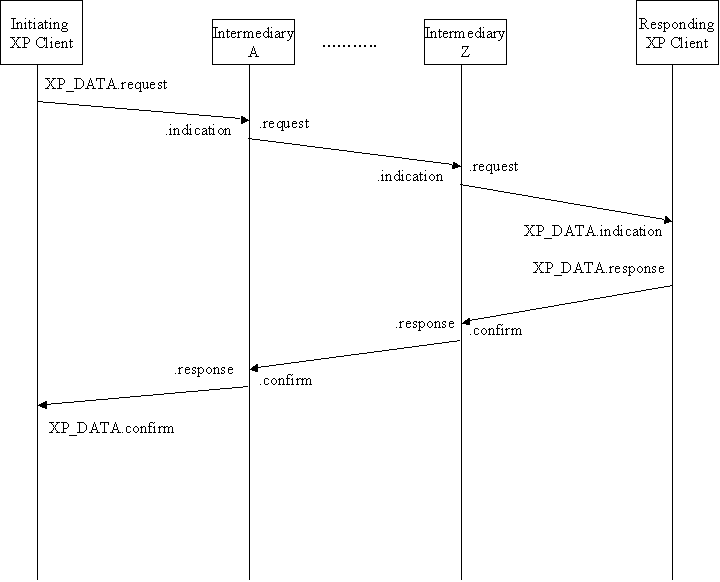
Interlocked XP_DATA operation through Intermediaries
Hop-by-Hop XP_DATA operation through Intermediaries
[Personally, I don't think this hop-by-hop pattern really
works. It's here to illustrate the difference and someone else may be able to
articulate circimstances where it would be of value... I am at a loss!]
The XP_UNITDATA service operating through intermediaries
follows a similar pattern. However, the .confirm primitives arise through
the operation of the underlying protocols between neighbouring XP layer
entities.
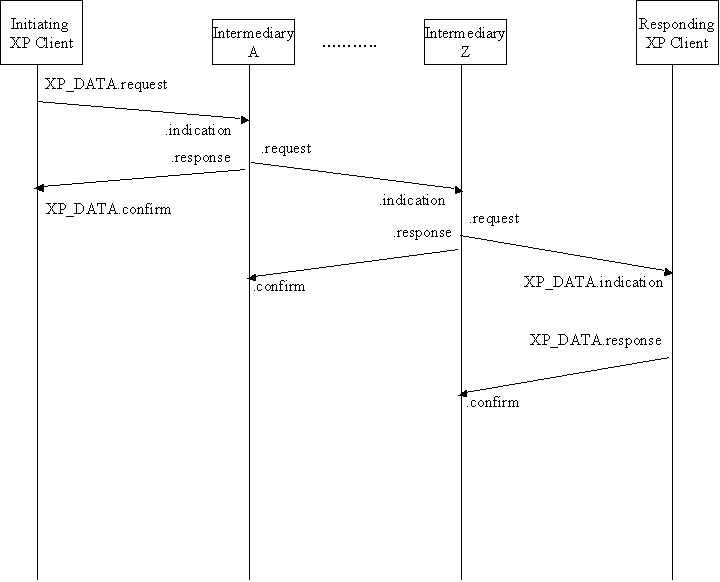
XP_DATA operation through
Intermediaries
5.
Layer Entities and Protocol Bindings
Bearing in mind that this is an abstract model, one of the
principal roles for an XP layer entity is to provide an abstraction for a
binding to an underlying protocol. In this context it is a container for the
abstract rules that combine parameters taken from .indication and .response
primitives (abstract) to form the outbound message and headers for the
underlying protocol and vice-versa in the case of inbound messages and the .indication
and .confirm primitives.
[I'd like to do a more detailed treatment of the SOAP HTTP
bindings to show how using this form of model it become a non-issue whether the
URI of the intended recipient is carried within the SOAP envelope or whether it
is carried within the HTTP headers – the binding will dictated the mapping
between underlying protocol headers, underlying protocol payload and XP service
parameters. Likewise the derivation of the SOAPAction header can be explained.
Also, the treatment of attachments would also be useful. I believe that we have
to define a default way to carry binary attachments within the XP message
envelope – possibly base64 and/or an escape mechanism for XML/text. Thus the
support for attachments becomes intrinsic, however the use of more efficient
underlying mechanisms for direct handling of binary become part of the binding.
I'd also suggest that the construction of manifest, concrete attachment URIs
and concrete attachment references be undertaken by the binding (or at least
exposed for manipulation by the binding)].
6.
Modelling SOAP
[This section at present is just a place holder – I'd like
to do a much more thorough job]
7.
References
[1]
"Simple Object Access Protocol (SOAP) v1.1"
[2]
"Axis Architecture Overview"
http://www.soap-wrc.com/axis/axis_arch_overview_v03.zip





